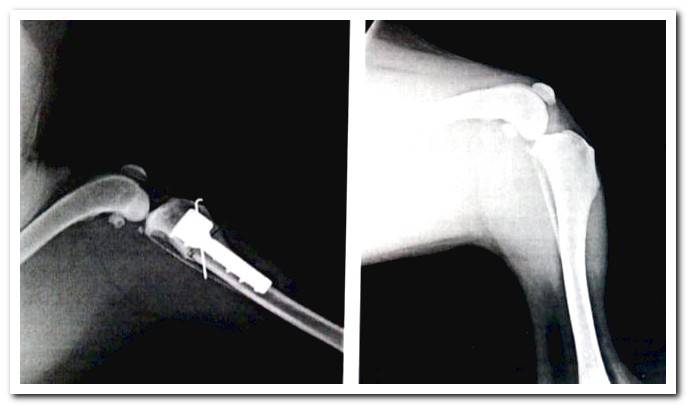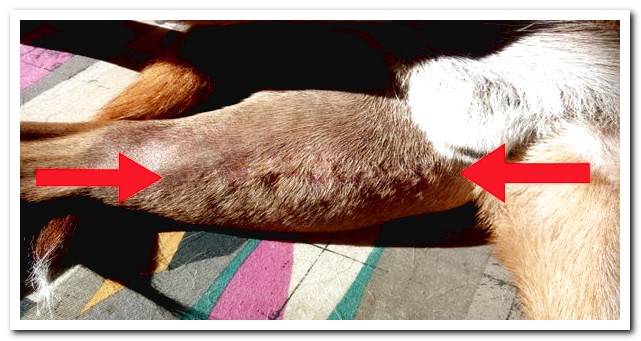
If you suspect that your dog may have a torn ligament or they have already confirmed it and you are looking for information about the available veterinary treatments, you are in luck because I will explain everything you need to know.
Remember that surgery should always be the last option, as it is the most invasive and requires a longer recovery. Furthermore, it does not always provide a solution to the problem.
Index of contents
- 1 What is cruciate ligament rupture?
- 2 How can a cruciate ligament tear a dog?
- 3 Cruciate Ligament Rupture Symptoms
- 4 Veterinary treatments
- 4.1 Plasma infiltrations
- 4.2 TTA surgical operation
- 5 How is the Postoperative? Care
What is cruciate ligament rupture?
Ligaments help the joints to function properly, so when any ligament breaks or degenerates, our dog will suffer pain and will need to be treated.
The cruciate ligament is the one that most often degenerates, tears, or ruptures, because it sustains a heavy workload when the dog walks, runs, or jumps. They are located on the knees, which can suffer from arthritis.
The rupture can be of the anterior or posterior ligament, the most frequent being the rupture of the “anterior”. When it degenerates, breaks, tears or inflames, the knee stops working properly causing a lot of pain.

How can a cruciate ligament tear a dog?
Dogs of more than twenty kilos in weight, that is to say, those of medium and large size, are those that have the greatest possibility of breaking any of these ligaments. Regardless of his age.
Young dogs generally experience a tear, hyperextension, or breakage due to a misstep, perhaps from stomping while running or from having screwed up a hole, creating trauma.
That is, young dogs generally suffer from this problem due to an accident. However, dogs over the age of six usually suffer a torn cruciate ligament due to wear.
Cruciate Ligament Rupture Symptoms
When it comes to partial breakage or initial wear it is difficult to detect without medical tests. However, when the damage is already done, the symptoms are very noticeable.
Our dog will begin to limp, occasionally or constantly. You will avoid resting the leg on the ground, holding it high (hanging). Sometimes we will also see inflammation in the knee.
- Lameness, especially after resting, when muscles and tendons are “cold”.
- Pain when resting the paw on the ground.
- Possible inflammation of the knee and surroundings.
If we appreciate any of these symptoms, we should go to a veterinaryn to carry out the necessary tests and indicate the diagnosis.

Veterinary treatments
Currently, there are two types of treatment to heal cruciate ligament rupture, one of them is invasive, through surgery and the other is reparative, through infiltrations.
It will always be the veterinaryn who, after analyzing the results of the tests, recommends us how to proceed. Each dog is different so each one needs a totally personalized treatment.
Plasma infiltrations
The least invasive therapy is plasma infiltration, something that will help the ligament to regenerate significantly (growth factors). The plasma is obtained from the blood of the dog itself, to avoid any type of rejection.
It is not always possible to carry out this treatment, it will depend on the state of the ligament. So it is possible that sometimes our vet does not recommend it to us. Infiltrations should be repeated every few years.
TTA surgical operation
Although it is not an open heart operation, it is still an important operation. It consists of advancing the tibial tuberosity, that is, removing a small piece of bone and using a plate so that the weld is carried out correctly.
With this it is possible to relax the ligament, thus preventing it from suffering and consequently reducing inflammation and pain in the dog. This technique offers quite high success rates.
Sometimes surgery does not solve the problem, resulting in permanent lameness. It is also possible to have complications like a seroma or infection / rejection.
How is the Postoperative? Care
With few exceptions, recovery is usually done at home since it takes a few months. During which our dog must not run, jump, climb / descend stairs or make sudden / strong movements.
Always follow the instructions of the vet who has operated, until the dog is discharged. In the meantime you should rest and have a quiet life, walk just enough to relieve yourself and always tied down during the walk, to prevent him from running.
It will be the vet who tells us when we can start taking longer walks, depending on how the weld evolves and general evolution. Just be patient and help your dog recover.
